The Changing College Landscape: How Coaches Are Counseling Recruits in a New World
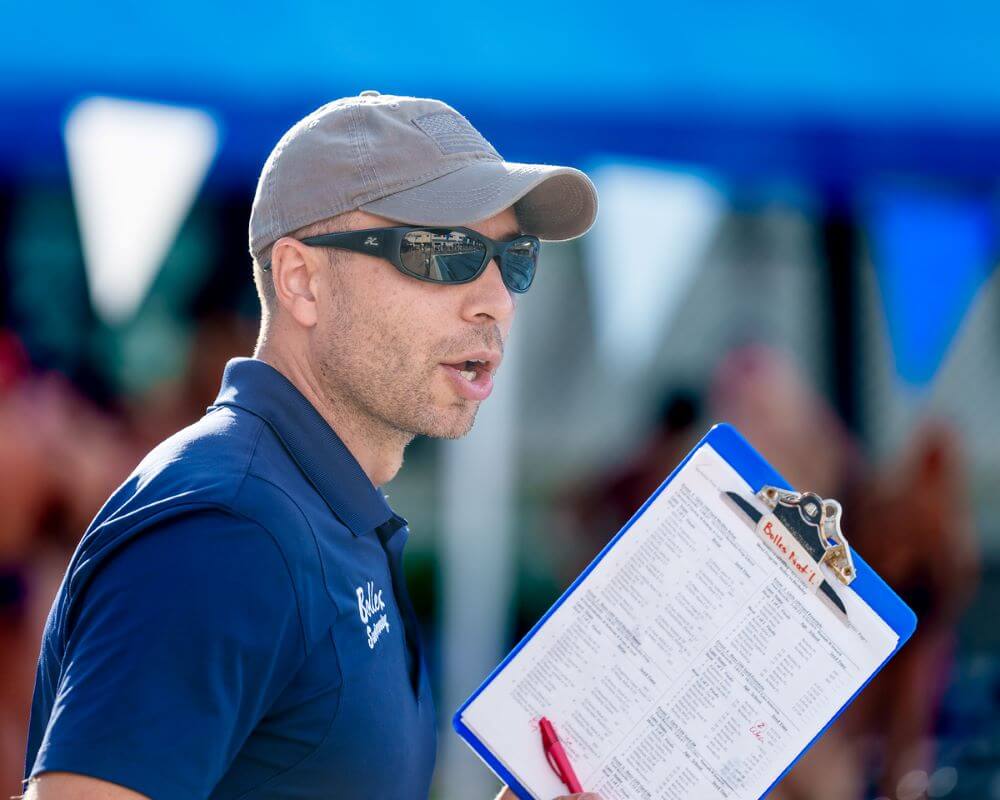
The Changing College Landscape: How Coaches Are Counseling Recruits
Let’s start by agreeing it is currently a crazy world for college swimming.
True story: Last fall, an all-state Mid-Atlantic swimmer decommitted from Boston College following revelations of misconduct in its men’s program. After careful introspection in spring 2024, he cast his lot with Notre Dame—only to have the Irish suspend its men’s varsity program amidst reports of gambling and culture issues. At the present time, this young man is a Notre Dame freshman and training in South Bend.
These days, the college world is clearly navigating uncharted waters. “There is still a lot of confusion regarding the House case and its impact,” says Joel Shinofield, former college coach, executive director of the College Swimming Coaches Association of America, and now managing director of sport development for USA Swimming. “There is a lot of misinformation out there and misunderstanding as well.
“Some coming dates will bring more clarity. Some conferences are meeting to discuss roster sizes. And some teams and conferences may decide not to opt in. All that has a bearing for college swimming prospects. I suspect some coaches may urge kids to come and train on club teams. What is really needed is honest conversations with recruits, parents, college and club coaches,” he says.
For an updated, ground-level view, Swimming World approached several of the country’s most respected high school and club coaches to hear what they are saying to their athletes about swimming at the next level. While there are some common themes, their perspectives are refreshing and thought-provoking.
RON BLANC, CO-HEAD COACH, SANTA MARGARITA HIGH SCHOOL (CALIF.)
• National high school coach of the year, 2014
• Winner of last five girls’ CIF (Calif.) swimming and diving titles
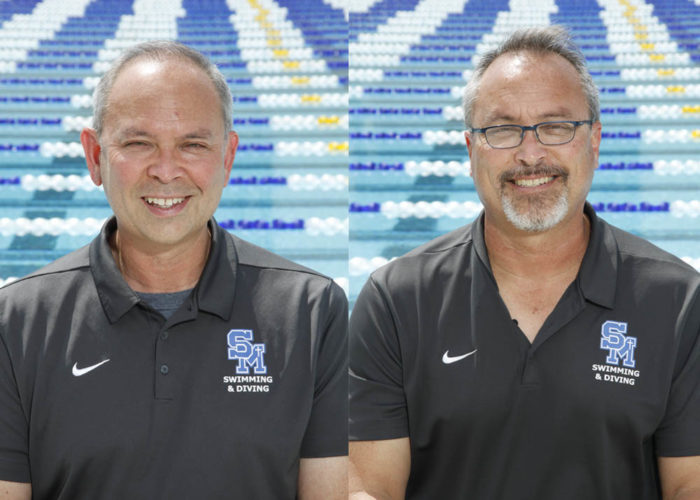 “With the recent changes to the NCAA landscape involving athletics, it is too soon to know how these changes may impact collegiate swimming and recruiting. The changes are so profound and potentially sweeping, my advice to our student-athletes is to continue to cast a wide net when looking at potential college swimming opportunities. Be open and transparent with coaches in your communication and don’t be afraid to ask questions. The learning process will be happening on the collegiate side, too.”
“With the recent changes to the NCAA landscape involving athletics, it is too soon to know how these changes may impact collegiate swimming and recruiting. The changes are so profound and potentially sweeping, my advice to our student-athletes is to continue to cast a wide net when looking at potential college swimming opportunities. Be open and transparent with coaches in your communication and don’t be afraid to ask questions. The learning process will be happening on the collegiate side, too.”
ABI LIU, HEAD COACH, BELLEVUE SWIM CLUB (WASH.)
• USA Swimming national junior team coach
• Pacific Swimming Coach of the Year
• Member, Chinese national team
“The recent changes in the college landscape have been challenging for high school athletes, particularly boys. With fewer spots available and cuts, it is even more competitive for men than women. We have been emphasizing the following with our athletes:
• You GET to continue your athletic career regardless of the division. There are many incredible schools in DII, DIII. Find yours.
• Be as versatile as possible. You want to be able to offer more than one event, one stroke to a team.
• Be a good student and teammate. What you bring to the team culture is just as important as how fast you swim in the pool.
• If you can’t get on the varsity team, find a local club team to continue your training. The development of boys comes later, at ages 19, 20; you will see big improvements.”
PETER VERHOEF, HEAD COACH/AQUATICS DIRECTOR, BOLLES SCHOOL (FLA.)
• Former college and club coach
• Led Bolles boys to Swimming World’s 2021 high school national championship
“For active recruits who have just lost interest from their target schools or had offers rescinded—this has happened twice this fall—we tell student-athletes to ‘pause for a moment and reset. These things are out of your control. You still have a place where you can swim in college; it just doesn’t look like what you thought a few weeks ago. That’s a hard reality. Let’s admit our frustration…then move forward.’
“We then start with what is most important to you in swimming as a sport: team connection, educational value, opportunity to compete, etc. From there, we create a short list of schools where our current times fit into their conference AND they meet our important factors. We also consider a gap year and junior college opportunities if needed. For most student-athletes in this position, this step forces them to think about what they really want—not just going to the best school possible.”
“For student-athletes who are about to start the college selection process, we first ask them to clearly define success in college. Being a small fish in a big pond rarely works well in the day-to-day of getting better. Having big goals—for example, Olympics, NCAA finals—are great, but what matters is how you show up each day. Know what helps you compete and train well—i.e., supportive teammates/coaches, etc.
“Next, we ask student-athletes to do research and know what events and places a college is going to expect them to score in. Evaluating where your current times as a sophomore/junior place you in their conference meet should inform your decision on who will be interested. Expect a coach to look for three scoring events to be a value-add to their roster. We ask our sophomores to send us a list of 10-15 schools to start the process before they make first contacts. This gives us a chance to guide them on what would be a good fit and the potential issues if they have a long list of ‘reach schools’ only.
“Bottom line: As coaches and parents, we need to encourage swimmers to focus on the love of the sport and the connection to a team as the primary driver of participation—not achievement. Kids who end up in programs where they just want to work hard and race for their team—and have opportunities to do so—will thrive and be successful. Student-athletes who are trying to select a college based on the times they want to go and the times they see on the team will struggle with the day-to-day process at that school. Such an approach starts with realistic self-awareness and a focus on the process of improving.”
DOUG WHARAM, ASSOCIATE HEAD COACH, COMPETITIVE DIRECTOR, NASHVILLE AQUATIC CLUB (TENN.)
• USA Swimming Select Camp staff member
• 2x USA Swimming Developmental Coach of the Year
• Age Group Coach of the Year finalist
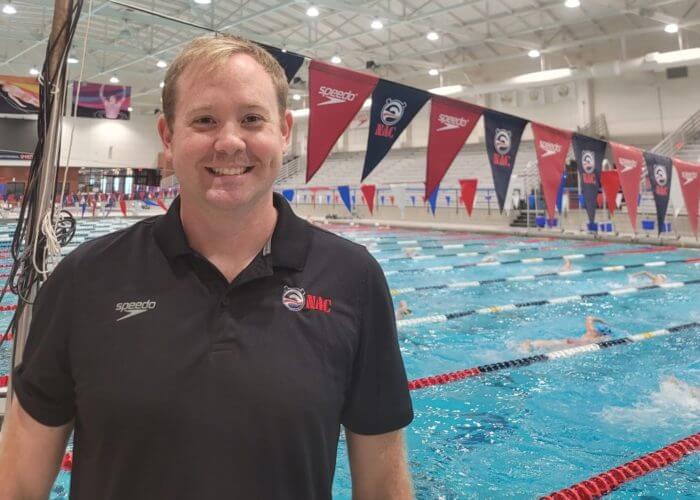
Photo Courtesy: Nashville Aquatic Club
“For the majority of athletes, college recruiting has always had an element of uncertainty, so in that sense, the current process isn’t much different. For all of our athletes—even the most talented and hardest working—we have always, and are continuing, to advise families to remain flexible, as there seems to be something new cropping up every month.
“More so now than in years past, this means exploring options at different levels—mid-majors, D-II and D-III. Most of our parents seem to have a good handle on this uncertainty. The athletes are struggling a bit more, as spots are being eliminated at the highest levels and the trickledown effect that it is creating means that ‘good fit’ options in the past may not be a good fit any more. Finally, we are reminding them that a lot of the college recruiting process is out of their control. So, stay focused on the elements of recruiting that you can control—i.e., grades and swimming performance.
“The major changes and the next real iteration of the college swimming landscape are still a year or two away from revealing themselves, I think. It’s definitely coming, and athletes should make sure they are with a club that can maximize their potential.”
CHAD ONKEN, CEO/OWNER, QUEST SWIMMING (VA.)
• Former college and USA Swimming national team coach
“There seems to be a new development in the recruiting landscape each and every day. It is challenging for sure. I think it’s essential for all parties involved—coach/athlete/parents—to have continuous, open and honest communication. We are fortunate to have a (2026) top 10 recruit on our team. She and I met regularly to discuss her phone calls and recruiting trips. Her parents and I texted fairly often as they attended each of the recruiting visits as well. I did my best to stay in touch with the college coaches as well so they could explain potential scenarios and what they were seeing/hearing with regards to the future of NCAA swimming.
“Communication is key for just about all aspects in life, but with the way things are in NCAA swimming/recruiting nowadays, it’s always good to overcommunicate to make sure everyone is on the same page.”
DON HEIDARY, CO-HEAD COACH/FOUNDER, ORINDA AQUATICS
• Head coach, Miramonte High School (1990-2022)
• Former president, ASCA
• Board member of World Swimming Coaches Association
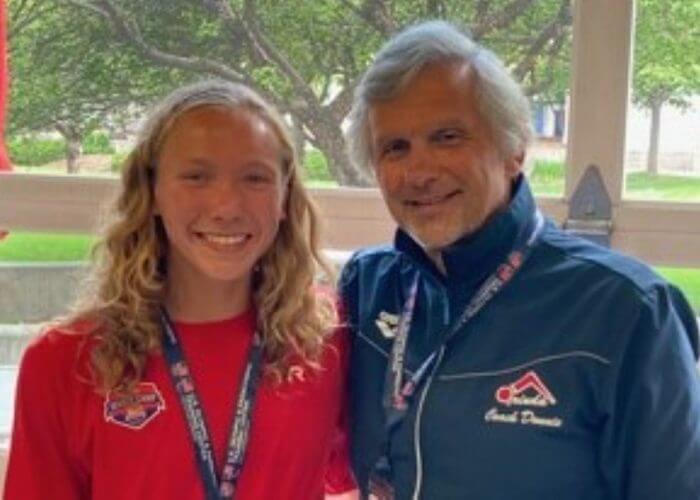
Courtesy: Orinda Aquatics
“Fortunately, at present, we have not seen or felt any fallout from the recent developments in this NIL era, though that may change in the coming years. That said, collegiate swimming has been a blessing to our program and to countless swimmers whose careers have been extended, and who have flourished as collegiate athletes, teammates and leaders.
“At Orinda Aquatics, we begin with the premise that every swimmer will/can be a collegiate athlete. While this may sound assumptive or aggressive, it is actually based more on a culture that supports, encourages and promotes it, rather than simply an expectation or hope.
Additionally, it becomes a motivating force both athletically and academically, which fuels retention that is critical to all clubs. This evolves into a positive feedback loop within the student-athlete that ultimately serves the athlete, the coach, team and the parent. When we ask our athletes why they want to swim in college, the answer is quite often, ‘I couldn’t imagine my life without it.’
“In supporting our athletes in their college searches, we never begin with which division a school is in. We start with fit as it relates to academics, athletics and, yes, admissions. When examining a swimmer’s academic objectives, desire/dedication, athletic potential and goals—and their ability to handle the stresses of both swimming and academics—we help them systematically cultivate a broad list. We then narrow it to reach, fit and back up schools with both swimming and non-swimming options.
“We suggest that all things being equal, swimming is an invaluable experience and we strongly recommend it. In this process, we look at three filters: academic, athletic and living—or classroom, team, community—and identify three critical factors of each. This dramatically limits the possibility of a scattershot approach. One swimmer may want to compete at the Olympic Trials or at the NCAA D-III Championships, while another simply loves the sport and wants to be a great teammate and contribute in any way they can to a program that allows them to focus on academics and other interests.
“Regarding the changing landscape in collegiate sports, I believe that roster limitations will ripple through the sport in the coming years, but there will be a reset in recruiting and in college searches. This can be mitigated by college prospects becoming adept at communicating with college coaches, having a tiered list and always examining worst-case scenarios. With the two-year recruitment window, I believe this can and will be navigated.
“With regard to NIL, I believe that 99% of high school/club athletes pursue collegiate sports for reasons other than money or compensation, and that includes scholarships. Their compensation is in the opportunity and experience—and privilege—of being a collegiate athlete; an opportunity to extend what we hope has been a life anchor, and the hope of creating treasured, lifelong memories and relationships. Certainly, options may narrow, as will potential scholarship money, but I firmly believe that high school and club swimmers who are sincere about pursuing collegiate experiences—and who are deliberate and well-reasoned in employing a thorough methodology—will have ample opportunity.”
SID CASSIDY, HEAD COACH, SAINT ANDREW’S SCHOOL (FLA.)
• USA Swimming national team coach
• Former college head coach
• 3x CSCAA All-American
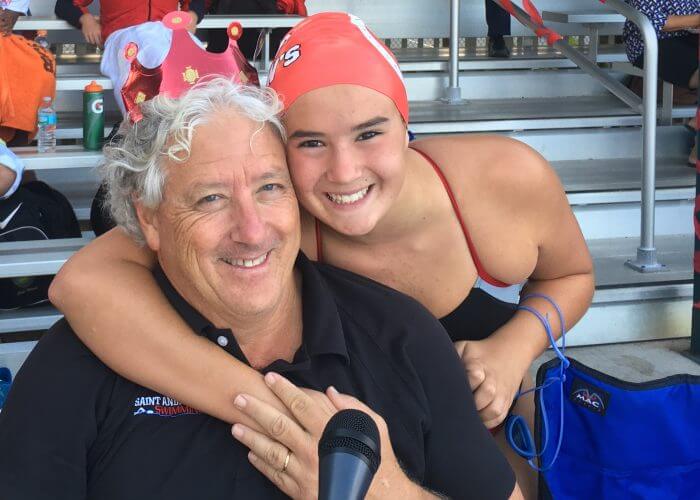
Sid Cassidy with Saint Andrews School Swimmer
“We are telling our students to be cautiously optimistic despite the many signs that collegiate swimming as it is now will soon change. If college swimming is different in five-to-ten years, I have to believe Saint Andrew’s swimmers will still have college swimming options, even if it is college club swimming. We have had a lot of graduates go to larger schools, want to keep swimming and who have found great joy in club swimming.
“We are a high-end academic institution, and a lot of our swimmers look at the better, smaller D-III schools. They see the success those schools without scholarships have and realize those programs will endure, too.”
Michael J. Stott is an ASCA Level 5 coach, golf and swimming writer. His critically acclaimed coming-of-age golf novel, “Too Much Loft,” is in its third printing, and is available from store.Bookbaby.com, Amazon, B&N and book distributors worldwide.



